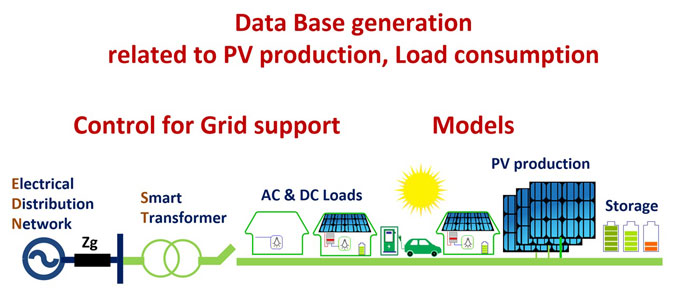Overall aim
The overall aim of this project is to strengthen research and training capacity in the field of photovoltaic (PV) systems and their integration in Tunisian electrical distribution network (EDN) by developing integrated approaches to investigate both technical and socio-economic aspect.
The project will be concerned with PV innovative solutions, energy storage technologies using power converters as grid interfacing technology in EDN, but also new methods, concepts and tools to face build capacities challenges, considering energy industry requirements and Tunisian university and research lab constraints.
The work undertaken will be of direct relevance to a wide variety of problems related to PV large scale integration. Problems related to ageing equipment of major distribution network equipment and unprepared materials and human skills to a fast and big growth of rooftop PV systems connected to distribution networks will be afforded.
This project will contribute to the development objective “Inclusive Private Sector Employment Increased”, identified by Tunisian Government within its proposed 2016-2020 Strategic Development Plan and meet USAID’s contribution objective for helping Tunisia surmount its economic and social challenges.
Technical Objectives
Data base generation related to PV production, Load consumption.
Accurate models development for PV, load, storage and grid for diagnosis and reconfiguration algorithms
Models for subsidies
Testbed and PHIL environment development for experimental and/or quasi experimental investigation and verifications, under different complex scenario-This will lead to new research methodology in the field of renewable energy systems based on power electronics and advanced control.
The target environment will provide system engineers with a better understanding of how photovoltaic (PV) inverters, and energy storage systems interact with the grid and react to grid disturbances.
For the energy industry, this will save time and resources while minimizing integration issues and advance the development of grid-friendly renewable and emerging technologies.
Solutions to be proposed to enhance the capacity of Tunisian electrical distribution network for large scale Rooftop PV systems integration
Attract private sector partner for rapid control prototyping of power electronics control for renewable energy systems
Innovation is expected at different levels:
Modelling, simulation tools, Control algorithms, validation procedure.
Modeling
Modelling components Accurate models for PV and storage units, considering specific problems like ageing, parametric drifts and shadowing for PV.
These models and load models will be based on data base generated in Tunisian conditions.
Modelling systems with technico-socio-ecomical aspects The whole residential nanogrid (ReNaG) will be simulated including the different nanogrid components (PV, Storage and loads), but also energy management system ( EMS), grid conditions, dynamic pricing and social behavior.
SimulationTools
The combination between real prototype (Solar PV inverter, linear loads), emulated systems (complex load, second-use batteries used in banks, series and parallel association of PV modules, grid) and /or virtual prototypes with PHIL concept.
Combination with different simulation tools to simulate systems with different and widely various time constant : PSIM software to cope with power electronics topologies and filters, EMTP-RV for electrical distribution network, Labview for supervision and monitoring.
Control, Estimation, Fault Detections and Reconfigurations Algorithms
Hierarchical control structure for PV inverter achieving basic function (current and voltage control, grid synchronization) PV specific functions (MPPT, ant-islanding protections), and ancillary functions for grid support (voltage and frequency regulation, active and reactive power control) and home energy management.
Validation Procedure
Models will be validated using available real systems (PV) and test protocol to create shadow on modules of different size of PV farms. Mix of virtual and real prototype to consider sever and complex scenario of rooftop system integration on Tunisian electrical distribution network.


